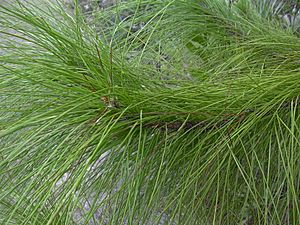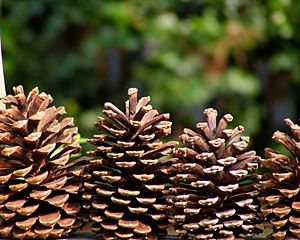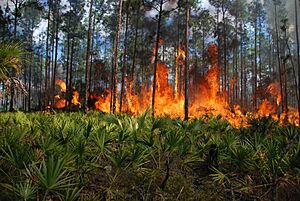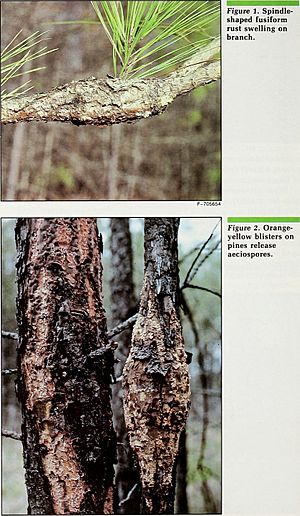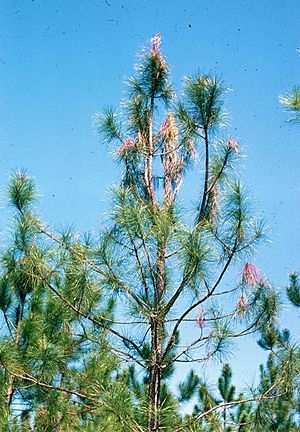Slash pine facts for kids
Quick facts for kids Slash pine |
|
|---|---|
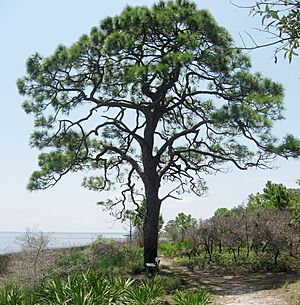 |
|
| Conservation status | |
| Scientific classification | |
| Genus: |
Pinus
|
| Species: |
elliottii
|
| Varieties | |
|
Pinus elliottii var. elliottii |
|
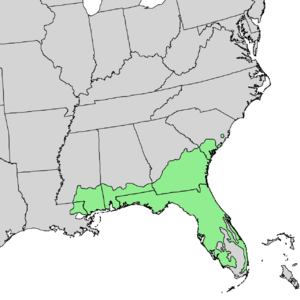 |
|
| Generalized natural range of Pinus elliottii | |
The Pinus elliottii, also known as slash pine, is a type of conifer tree. It grows mainly in the Southeastern United States. People call it "slash pine" because it often grows in "slashes," which are swampy areas with lots of trees and bushes. Other names for it include swamp pine or yellow slash pine.
For a long time, slash pine has been very important for making things like turpentine and resin. It's also used for timber. This tree is special because its wood is super strong, even stronger than many other types of wood. There are two main kinds, or varieties, of slash pine: P. e. var. elliottii and P. e. var. densa.
Contents
What is a Slash Pine Like?
Slash pines grow quickly, but they don't live as long as some other pine trees, usually up to 200 years. They can reach heights of 18–30 m (59–98 ft) and have trunks about 0.6–0.8 m (2.0–2.6 ft) wide. Their leaves are like long, thin needles, usually found in groups of two or three. These needles are about 18–24 cm (7.1–9.4 in) long.
The tree's cones are shiny and reddish-brown. They are 5–15 cm (2.0–5.9 in) long and have a small, thick spike on each scale. Slash pine is known for its cone shape and its incredibly strong wood. Its wood is stronger than many hardwoods, like white ash. This means it's very tough for its weight!
You can tell a slash pine apart from its relatives. It has longer, shinier needles and bigger, red-brown cones than the loblolly pine. It also has shorter, thinner needles and smaller cones than the longleaf pine.
Different Kinds of Slash Pine
There are two main varieties of Pinus elliottii:
- P. e. var. elliottii (the typical slash pine): This kind grows from South Carolina to Louisiana and down to central Florida. Its needles usually come in bundles of three. Its cones are larger, about 7–15 cm (2.8–5.9 in).
- P. e. var. densa (South Florida slash pine): This variety is found in the pine rocklands of southern Florida and the Florida Keys. Its needles are almost always in bundles of two and are longer. Its cones are smaller, about 5–12 cm (2.0–4.7 in). This wood is even denser, and the tree has a thicker main root. Unlike the typical slash pine, young P. e. var. densa trees have a "grass stage" where they look like grass for a while. This variety doesn't like cold weather, so it only grows in South Florida.
Where Slash Pines Grow
Slash pine trees are mostly found in Florida and Georgia. Their natural home is in sandy, subtropical forests and wet flatlands. They grow best in warm, humid places where the average temperature is around 17 °C (63 °F). They can handle temperatures from −18 to 41 °C (0 to 106 °F).
Slash pines can grow in many types of soil. However, they do better near water, like swamps and ponds. This is because the soil stays wetter, and young trees are more protected from wildfires. These forests have been managed with controlled fires for a long time. Young slash pine trees are very sensitive to fire in their first year. The P. e. var. densa is more resistant to fire because it has thicker bark.
Fire and Slash Pine Forests
Why Fire is Important
Fire has always been a big part of forests in the Southeastern United States. Native Americans used to burn land to help grass grow for animals and to make it easier to hunt. When Europeans arrived, they brought diseases that reduced the Native American population. This meant less burning happened, and many open areas turned back into forests.
Later, logging increased, causing disagreements about burning. Loggers wanted to keep burning, but farmers worried about their cattle and turpentine production. For a while, people tried to stop all wildfires, like with the Smokey Bear campaign in the 1940s. This led to more shade-loving trees growing in these fire-dependent forests. However, by the 1950s and 1960s, people started to realize the benefits of controlled burning again. Fire helps new pine trees grow, controls plant diseases, and reduces the risk of huge wildfires.
How Fire Helps the Ecosystem
Without regular fires, slash pine forests can change a lot. For example, in some areas, they can turn into forests with more oaks, hickory, and southern magnolia trees. In South Florida, the pine rocklands can become filled with woody shrubs and plants that don't belong there.
Many pine trees and native plants actually need fire to survive. Fire helps their pine cones open and their seeds sprout. It also helps with other important plant processes. Fire can also be a good way to control invasive plants, which are often not adapted to fire. This means fire can kill them or stop their seeds from growing.
Controlled burning also helps reduce plant diseases and pests. It can clear out dead plants and provide nutrients to the soil, helping other plants grow. Fire also prevents too much "fuel" from building up, like dry grasses and bushes. If too much fuel builds up, a wildfire could become very dangerous. Most controlled burns happen every 2–5 years, giving the ecosystem time to recover.
Slash Pine Diseases
Fusiform Rust
Starting in the late 1950s, a disease called fusiform rust caused a lot of problems for slash pine, loblolly pine, and longleaf pine trees. This disease is caused by a fungus and mostly infects young trees in new plantations. At that time, the pine industry was growing fast, and many young forests were badly hit because the trees weren't old enough to fight off the disease.
This fungus, Cronaritum quercuum f. sp. fusiforme, has a complicated life cycle. It needs two different plants to complete its life cycle: a pine tree and an oak tree. The fungus spreads its spores from oak trees to pine needles, usually between March and May. The fungus then grows into the pine tree's stems. Later, it releases spores from the pine tree that infect oak trees. On oak leaves, the fungus makes more spores that can infect other oak trees. Finally, these spores change again and infect pine trees, completing the cycle.
When pine trees get fusiform rust, they can develop galls (swollen growths), cankers (open sores), and their stems might swell or die back. These cankers can also let other fungi or pests into the tree. Scientists have learned that warm temperatures (around 15–29 °C (59–84 °F)), high humidity, and wet pine needles can make the disease spread more easily.
Since oak trees are also important, removing them all isn't possible or effective. Instead, people use a mix of strategies to manage the disease. These include planting pine trees that are more resistant to the rust and using controlled fires to reduce the number of oak trees in the forest.
Pitch Canker
Pitch canker is another disease caused by a fungus, Fusarium circinatum. It was first noticed in 1946, but it became a huge problem in the 1970s, causing many slash pines in Florida to die. Some scientists think this fungus might have come from Mexico. It can infect almost all types of pine trees, including longleaf pine and eastern white pine.
This disease is still a problem in tree nurseries. It can spread through seeds and spores. However, the fungus needs an open wound to get into a tree. These wounds can come from insect damage, machines, or even hail.
When a tree has pitch canker, its needles might turn yellow or red, and the shoots (new branches) can die. Cankers or sores can form on the trunk, making the bark yellow or dark brown and causing sticky resin to ooze out. Sometimes, the part of the tree above the canker dies. Resin is usually made by plants to protect themselves from diseases. The severity of the disease depends on the weather and if the tree has wounds. Some insects, like bark beetles and weevils, can also carry the disease to trees.
How Slash Pine is Used
Slash pine trees are widely grown in tree plantations. This means they are planted in large numbers to be harvested for wood. They are also used in horticulture, which is the art and science of growing plants. Their strong wood makes them valuable for many different products.
See also
 In Spanish: Pino ellioti para niños
In Spanish: Pino ellioti para niños



